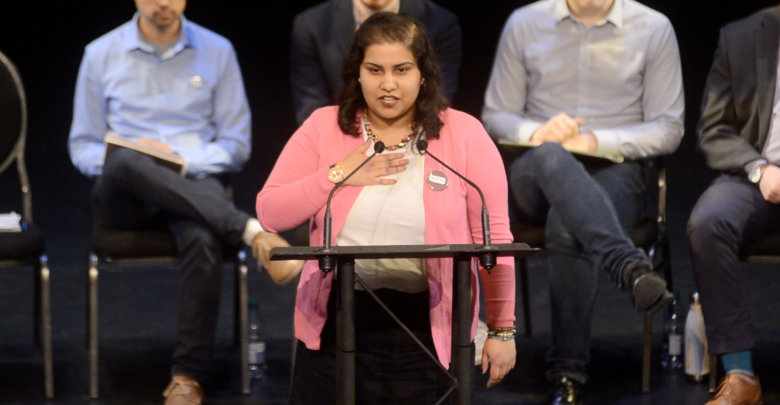 Oumar Salifou
Oumar SalifouEach year, The Gateway publishes an evaluation of the Students’ Union Executive and the Board of Governors representative. It’s impossible to discuss every aspect of their tenures, so these reports are largely based on the major components of the platform each executive campaigned on, and the most significant responsibilities of their respective positions. These evaluations were informed by interviews with the executives themselves. The grading rubric can be found below. And if you’re short for time, check out our TLDR for a bite-sized breakdown.
Akanksha Bhatnagar: C+
The president of the Students’ Union executive. This is a role everyone knows about, whether you’re involved in student governance or not. However murky the particulars of the job might be, students know who the president is. As the spokesperson and face of the SU, the visibility of the presidency means that they can’t often hide their mistake. Akanksha Bhatnagar has done a lacklustre job this year at representing students, completing her goals, and heading the SU executive team.
The UCP budget has, understandably, derailed some things on campus. Bhatnagar’s plans to look at deferred maintenance went out the window, along with improvement of mental health services, hiring a sexual violence coordinator, and increasing non-repayable grants for students. Some of these things could be blamed on other members of the executive team, but ultimately it is in the president’s portfolio to coordinate this. At the same time, things like deferred maintenance are almost out of the SU’s grasp, so why was she promising these things in her campaign?
As for building new relationships with the provincial government, which was a point she stressed in her platform, that didn’t happen. Whether that is because of the seemingly volatile relationship between the current government and students or because there wasn’t enough effort put in, we will never know. All we see is the surface, and the surface doesn’t look nice.
One of the biggest points in Bhatnagar’s platform was the provision of free menstrual products on campus. While she did make them available, they mostly sit on InfoLink desks in baskets. Does this strike you as uncomfortable? Many people who need them might feel the same. When asked about this, Bhatnagar says she believes she has achieved this goal 80 per cent. She then spoke about dispensers, and how it was difficult to find sponsorships for the university demographic.
The Charter of Student Rights was also a hot issue during last year’s elections. Bhatnagar promised that it would be completed this year, and that she would implement an awareness campaign so that students could be educated on their rights. This charter has been in progress for over three years now, and when they came out with it, it was just three pages long. The “page per year” joke made its rounds, but this is serious. I wrote longer essays in my first year than that charter. Apparently it’s still in progress, but what can we expect for future presidents? One page for every election? That isn’t good enough when real students are facing the consequences.
One of the things she is most proud of is the new marketing for the SU, but even this has been criticized by some students. She claims that there are more students than ever getting involved with the SU, but STRIDE attendance is reportedly down this year, and attendance at Student Leaders Week was abysmal. At what point do we acknowledge the failure to connect with students? How low does voter turn-out have to get?
TLDR: Bhatnagar, for all her success last year, did an average job this year. With some of her largest platform points standing incomplete or improperly completed, I cannot overstate the mediocrity of this year’s SU executive. The barriers put in place by a hostile government do not excuse the limited progress made this year. In her role as president, it almost felt like Bhatnagar continued to act as a vice-president (academic), and that was ultimately her downfall.
A-range: This person has fulfilled the promises they campaigned on and more, has created tangible change during their tenure, and has shown a commitment to improving the lives of students. Their GPA is top tier.
B-range: This person has done their job consistently well, but has not made any remarkable changes, or has fallen short on important goals they set out in their platforms. They’re doing fine, but it’s nothing to phone home about.
C-range: This person has done their job sufficiently, but has failed to make significant progress in the areas most relevant to their portfolio, or has essentially abandoned a major part of their platform. They’re still passing with a safe buffer though, and Cs get degrees!
D-range: This person has done a very lacklustre job, and has not sufficiently fulfilled their campaign promises or the responsibilities of their position.
F-range: This person has not done their job, has not represented students, and has not fulfilled their campaign promises whatsoever.
CORRECTION: A previous version of this article implied that Bhatnagar did not know the going rate of a dispenser for menstrual products, citing a Google search that showed lower prices than the ones asserted by Bhatnagar. It later came to The Gateway’s attention that the figures quoted by Bhatnagar were ones given to her by the University of Alberta, which included labor, materials, and the dispenser itself. We have removed the sentences about the Google search to reflect this. The Gateway regrets this error.




